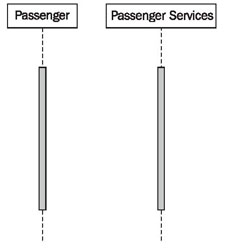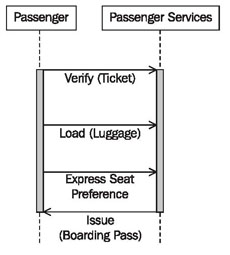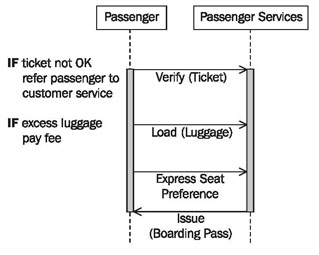Constructing Sequence Diagrams
The following checklist shows the necessary steps for the construction of sequence diagrams. Subsequently, we will further explain the individual steps.
Checklist 3.5 Constructing Sequence Diagrams in the External View
- Designate actors and business system—Who is taking part?
- Designate initiators—Who starts interactions?
- Describe the message exchange between actors and business system—Which messages are being exchanged?
- Identify the course of interactions—What is the order?
- Insert additional information—What else is important?
- Verify the view—Is everything correct?
Designate Actors and Business System—Who is Taking Part?
Sequence diagrams illustrate the interactions between actors and the business system. Fundamentally we have a pool of interaction partners from the use case diagrams. Depending on the flow that is being depicted in the sequence diagram, the appropriate actors and business systems can be selected from this pool.
In our case study (see Figure 3.24), we find the interaction partners passenger and passenger services for the above sequence diagram (Figure 3.23):

Designate Initiators—Who Starts Interactions?
For every sequence of interactions the actor who starts the interaction has to be identified. This actor is called the initiator. Since in the external view of the business model each business use case is initiated by an actor, we can here also select the actor from the pool of actors in the use case diagrams.
In our sequence diagram passenger check-in, the passenger starts the interaction by utilizing the service check-in from passenger services.
Describe the Message Exchange between Actors and the Business System—Which Messages are being Exchanged?
After the initiator has been defined, the subsequent progression of interactions has to be identified. For each communication step it has to be determined what information is exchanged. In this way the message will be defined. Messages are requests to do something directed toward a particular partner. The business objects that are exchanged with these messages also have to be defined.
Identify the Course of Interactions—What is the Order?
All messages are exchanged in a chronological order that has to be identified. Messages are inserted along the y-axis in increasing chronological order, from top to bottom (see Figure 3.25):

Insert Additional Information—What Else is Important?
Important activities of involved actors and business systems and important conditions can be inserted into the diagram as comments. Comments are inserted at the level of the appropriate message. Restrict this to important comments that have significance so that the diagram is not overcrowded with text (see Figure 3.26):

Verify the View—Is Everything Correct?
Completed sequence diagrams can be verified with the following checklist:
Checklist 3.6 Verifying Sequence Diagrams in the External View
- Are all required sequence diagrams completed and available? There should be a sequence diagram for each business use case.
- Are the sequence diagrams correct? Each sequence diagram contains only one object that represents the business system, and at most as many other objects as there are actors assigned to the business use case.
- Is each actor that is listed in the use case diagram mentioned in at least one sequence diagram?
- Is each actor who initiates a business use case mentioned as a starting point in one of the sequence diagrams?
- Have all the important comments been inserted into the diagram? Are there maybe too many comments inserted into the diagram thereby reducing its clarity?